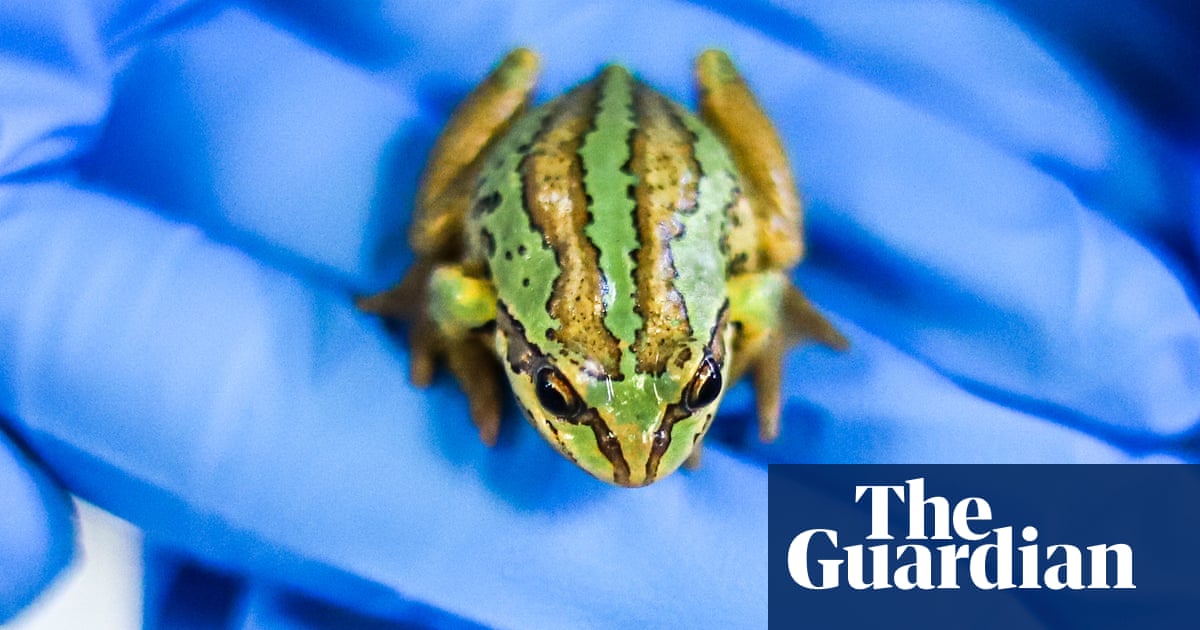The number of critically endangered alpine tree frogs, found only in the Australian alps, has crashed by about 80% since the 1980s.
Populations have been hit by chytrid fungus, a disease that hasdevastated amphibian populations globally. But a newstudyhas found a surprising silver lining that – for now – is helping the species hang on in the face of extinction.
Researchers at the University of Melbourne found that male alpine tree frogs with the deadlychytridiomycosisbreed more prolifically than healthy frogs. The infected frogs produce higher-quality sperm, display brighter throat patches during mating displays and sire nearly a third more offspring.
Researchers believe it’s a trade-off: the frogs shift their energy from fighting infection to reproducing – a last-ditch evolutionary push to pass on their genes.
The phenomenon is rare in the animal kingdom, but not unheard of. Similar behaviour has been observed in female Tasmanian devils with facial tumours, which tend toreproduce earlier and in greater numbers.
Still, the authors of the alpine frog study say the trend is not a long-term safeguard against extinction.
“This increased reproduction is able to offset the mortality, but it doesn’t help them build their populations back up,” said lead researcher Dr Laura Brannelly.
Once common throughout the alpine regions of Victoria and New South Wales,Litoria verreauxii alpinanow survives in just eight fragmented strongholds across both states.
Chytrid fungus spreads through water. It infects the outer layer of the frog’s skin, disrupting their system for regulating respiration, water and electrolytes and ultimately killing them via cardiac arrest.
Sign up for Guardian Australia’s breaking news email
It is blamed for extinction of at least seven Australian frog species – including thegastric-brooding frog, famous for giving birth through its mouth and last seen in 1981. While disease remains the primary driver of the species’ decline, it is not the only threat they face.
Brannelly said habitat loss, drought and bushfires are compounding the risk. Global heating is drying out boggy alpine wetlands, that the frogs rely on for breeding grounds, she said, and four-wheel driving, dam construction, hunting and fishing have all damaged fragile habitats.
“There’s a lot of recreation up there,” she said. “If we can support those groups to also be creating spots that supportalpina, plus the recreation, then we can hit all the marks.”
Her team’s research recommends creating artificial breeding ponds and corridors between the frog populations, to help boost the species’ chances of survival.
Tracking the frogs to gather the study’s data was not easy. Brannelly and her team spent nights driving through Mount Hotham in the Victorian Alps, periodically turning off the engine to listen for the gravelly whistle of the male’s mating call – a sound that used to echo through the region.
They followed the sound and waded through bogs and snowmelt streams to find the frogs – tiny, cold, and remarkably hardy.
Growing up to just 3cm long, alpine tree frogs range in colour from bright green to mottled brown, often with spots or stripes.
Sign up toBreaking News Australia
Get the most important news as it breaks
after newsletter promotion
They blend almost seamlessly into their surroundings. Their most extraordinary trait, however, might be their ability to survive after being frozen, something researchers still do not fully understand.
“Sometimes you find one and you think, ‘Oh my god, there’s a frozen dead frog’ – and then it will just come back to life,” Brannelly said.
But even with this resilience, the species is under significant pressure.
Nick Clemann, a senior herpetology biologist at Zoos Victoria, said the frogs’ survival is “on a knife’s edge”.
“The alpine tree frog used to be widespread and found in high density,” he said. “Before the disease hit, you would have heard lots of males calling in the wild.”
They are typically hardy, with tadpoles found swimming even in water pooled inside discarded tyres.
Clemann said the frog’s disappearance from alpine ecosystems, where few cold-blooded animals live, was “catastrophic.”
Frogs play a crucial ecological role, controlling insect populations, serving as prey for birds, fish and other wildlife and filtering water as tadpoles.
The alpine frog is listed as endangered in NSW, and critically endangered in Victoria, giving impetus to conservation efforts. But Clemann said the real work is happening at ground level, driven by “dedicated individuals and organisations”.
“That’s where the difference is made.”
Clemann agreed with Brannelly that the most practical path forward is habitat modification – for conservationiststo create artificial environments to support breeding habitat.
He believes protecting the alpine tree frog and its habitat requires practical collaboration between traditional custodians, regulators such as Parks Victoria, and recreational visitors to the habitat.
